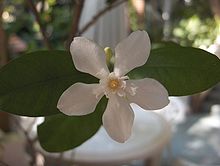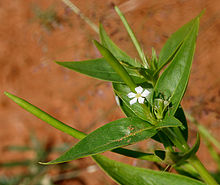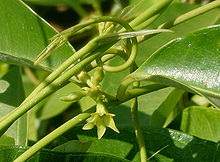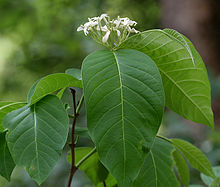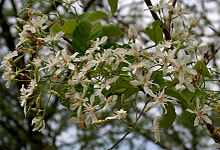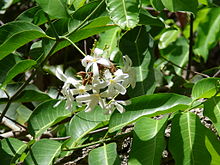- Apocynaceae
-
Apocynaceae 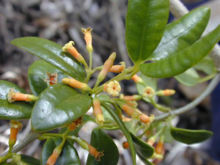
Alyxia oliviformis Scientific classification Kingdom: Plantae (unranked): Angiosperms (unranked): Eudicots (unranked): Asterids Order: Gentianales Family: Apocynaceae
Juss.Type genus Apocynum
L.Genera Synonyms The Apocynaceae or dogbane family is a family of flowering plants that includes trees, shrubs, herbs, and lianas.
Many species are tall trees found in tropical rainforests, and most are from the tropics and subtropics, but some grow in tropical dry, xeric environments. There are also perennial herbs from temperate zones. Many of these plants have milky sap; and many species are poisonous if ingested. Some genera of Apocynaceae, such as Adenium however, have either clear and milky, latex sap, and others, such as Pachypodium, always have clear sap.
Contents
Taxonomy
The family, as currently recognized, includes some 1500 species divided in about 424 genera. The family Asclepiadaceae is now, according to AGP II, included in the Apocynaceae.[1]
There are five subfamilies:
- Apocynoideae
- Asclepiadoideae
- Periplocoideae
- Rauvolfioideae
- Secamonoideae
The former two sub-families were part of the Apocynaceae sensu stricto, whilst the latter three sub-families used to belong to the Asclepiadaceae. The Apocynaceae is the result of a conflation of the two families.
A common term for the family is dogbane family, after the American plant known as dogbane, Apocynum cannabinum.[2]
Distribution
Species in this family are distributed mainly in tropical regions:
- In the rainforests and swamps of Indomalaya: small to very tall evergreen trees up to 80 m tall, often with buttress roots, such as Alstonia and Dyera.
- In northern Australia: small evergreen trees such as Alstonia, Alyxia, Cerbera and Ochrosia.
- In deciduous forests of Africa and India: smaller trees such as Carissa, Wrightia and Holarrhena.
- In tropical America, India, Myanmar and Malaya: evergreen trees and shrubs, such as Rauvolfia, Tabernaemontana and Acokanthera.
- In Central America: Plumeria, or the frangipani, with its waxy white or pink flowers and a sweet scent.
- In South America, Africa and Madagascar: many lianas such as Landolphia.
- In the Mediterranean region: Nerium, with the well-known oleander or Be-still tree (Nerium oleander).
- The only genera found in temperate Europe away from the Mediterranean are Vinca (Apocynoideae) and Vincetoxicum (Asclepiadoideae).
- In North America: Apocynum, dogbane or Indian hemp, including Apocynum cannabinum, a traditional source of fiber.
- In continental southern Africa (Angola, Botswana, Mozambique, South Africa, Swaziland, and Zimbabwe) and Madagascar, except for the humid evergreen forest of the eastern side of Madagascar, and never above 2000 m for the entire island: Pachypodium.
Characteristics
The dogbane family consists of trees, shrubs, herbs, or lianas with milky sap. The leaves are simple, usually opposite and decussate, or whorled; lacking stipules. Flowers are usually showy, actinomorphic, aggregated in cymose or racemose inflorescences (rarely fasciculate or solitary). They are perfect (bisexual), with a synsepalous, 5-lobed calyx that is united into a tube at the base. Inflorescences are terminal or axillary. Five petals are united into a tube with 4-5 epipetalous stamens. The style is expanded at the apex into a massive clavuncle just below the stigma. The ovary is usually superior.
The fruit is a drupe, a berry, a capsule or a follicle.
Genera
Apocynoideae
- Acokanthera
- Adenium
- Aganonerion
- Aganosma
- Alafia
- Allamanda
- Allomarkgrafia
- Allowoodsonia
- Alstonia
- Alyxia
- Amalocalyx
- Ambelania
- Amsonia
- Ancylobotrys
- Anechites
- Angadenia
- Anodendron
- Apocynum
- Arduina
- Artia
- Asketanthera
- Aspidosperma
- Baissea
- Beaumontia
- Bousigonia
- Cabucala
- Callichilia
- Calocrater
- Cameraria
- Carissa
- Carpodinus
- Carruthersia
- Carvalhoa
- Catharanthus
- Cerbera
- Cerberiopsis
- Chamaeclitandra
- Chilocarpus
- Chonemorpha
- Cleghornia
- Clitandra
- Condylocarpon
- Couma
- Craspidospermum
- Crioceras
- Cycladenia
- Cyclocotyla
- Cylindropsis
- Delphyodon
- Dewevrella
- Dictyophleba
- Dipladenia
- Diplorhynchus
- Dyera
- Ecdysanthera
- Echites
- Elytropus
- Epigynium
- Eucorymbia
- Farquharia
- Fernaldia
- Forsteronia
- Funtumia
- Galactophora
- Geissospermum
- Gonioma
- Grisseea
- Gymnema
- Hancornia
- Haplophyton
- Himatanthus
- Holarrhena
- Hoya
- Hunteria
- Hymenolophus
- Ichnocarpus
- Isonema
- Ixodonerium
- Kamettia
- Kibatalia
- Kopsia
- Lacmellea
- Landolphia
- Laubertia
- Laxoplumeria
- Lepinia
- Lepiniopsis
- Leuconotis
- Lochnera
- Lyonsia
- Macoubea
- Macropharynx
- Macrosiphonia
- Malouetia
- Mandevilla
- Mascarenhasia
- Melodinus
- Mesechites
- Micrechtites
- Microplumeria
- Molongum
- Mortoniella
- Motandra
- Mucoa
- Neobracea
- Neocouma
- Nerium
- Nouettea
- Ochrosia
- Odontadenia
- Oncinotis
- Orthopichonia
- Pachypodium
- Pachouria
- Papuechites
- Parahancornia
- Parameria
- Parepigynum
- Parsonsia
- Peltastes
- Pentalinon
- Petchia
- Picralima
- Plectaneia
- Pleiocarpa
- Pleioceras
- Plumeria
- Pottsia
- Prestonia
- Pycnobotrya
- Quiotania
- Rauvolfia
- Rhabdadenia
- Rhazya
- Rhigospira
- Rhodocalyx
- Rhyncodia
- Saba
- Schizozygia
- Secondatia
- Sindechites
- Skytanthus
- Spirolobium
- Spongiosperma
- Stemmadenia
- Stephanostegia
- Stephanostema
- Stipecoma
- Strempeliopsis
- Strophanthus
- Tabernaemontana
- Tabernanthe
- Temnadenia
- Thenardia
- Thevetia
- Tintinnabularia
- Trachelospermum
- Urceola
- Urnularia
- Vahadenia
- Vallariopsis
- Vallaris
- Vallesia
- Vinca
- Voacanga
- Willughbeia
- Woytkowskia
- Wrightia
- Xylinabaria
- Xylinabariopsis
The following genera used to belong to the family Asclepiadaceae:
- Araujia
- Asclepias (subfamily Asclepiadoideae)
- Caralluma
- Ceropegia
- Cionura
- Cynanchum
- Periploca (subfamily Periplocoideae)
- Vincetoxicum
Uses
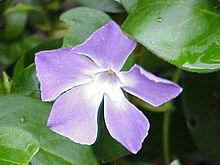 Vinca major, a popular garden plant
Vinca major, a popular garden plant
Several plants of this family had economic uses in the past.
The genera Carpodinus, Landolphia, Hancornia, Funtumia and Mascarenhasia were used as a commercial source of inferior rubber.
The juice of Acokanthera species such as A. venenata and the milky juice of the Namibian Pachypodium has been used as venom for arrow tips by the Bushmen. Some sources state that Pachypodium do not have a milky sap.[3]
Several genera are grown as ornamental plants, including Amsonia (bluestar), Nerium (oleander), Vinca (periwinkle), Carissa (Natal plum, an edible fruit), Allamanda (golden trumpet), Plumeria (frangipani), Thevetia (lucky nut), Mandevilla (Savannah flower), Adenium (desert-rose).
Some are sources of important drugs, such as cardiac glycosides, which affect heart function. These include the Acokanthera, Apocynum, Cerbera, Nerium, Thevetia and Strophantus. Rauvolfia serpentina, or Indian Snakeroot, yields the alkaloids reserpine and rescinnamine, which are useful tools in the treatment of high blood pressure and even some forms of psychosis. Catharanthus roseus yields alkaloids used in treating cancer.
The genus Apocynum was used as a source of fiber by Native Americans.
The edible flower of Fernaldia pandurata (common name: loroco) is a popular part of El Salvadorian and Guatemalan cooking.
References
- ^ Mary E. Endress and Peter V. Bruyns (2000). "A revised classification of the Apocynaceae s.l.". Botanical Review 66 (1): 1–56. doi:10.1007/BF02857781.
- ^ Charles Bixler Heiser (2003). Weeds in my garden: observations on some misunderstood plants. Portland, Oregon: Timber Press. p. 50. ISBN 0881925624. http://books.google.com/?id=nN1ohECdSC8C&pg=PA50&dq=Apocynaceae+dogbane#v=onepage&q=Apocynaceae%20dogbane&f=false.
- ^ S. H. J. V. Rapanarivo & A. J. M. Leeuwenberg (1999). "Taxonomic revision of Pachypodium Series of revisions of Apocynaceac XLVIII". In S. H. J. V. Rapanarivo. Pachypodium (Apocynaceae): Taxonomy, Habitats and Cultivation. Balkema. pp. 1–82. ISBN 9789054104858. "... Adenium species have either clear sap or white latex. Pachypodium ... always has clear sap""
External links
 Data related to Apocynaceae at Wikispecies
Data related to Apocynaceae at Wikispecies- Apocynaceae in L. Watson and M. J. Dallwitz (1992 onwards).
- The Genera of Asclepiadoideae, Secamonoideae and Periplocoideae (Apocynaceae)
Categories:- Apocynaceae
- Asterid families
Wikimedia Foundation. 2010.

